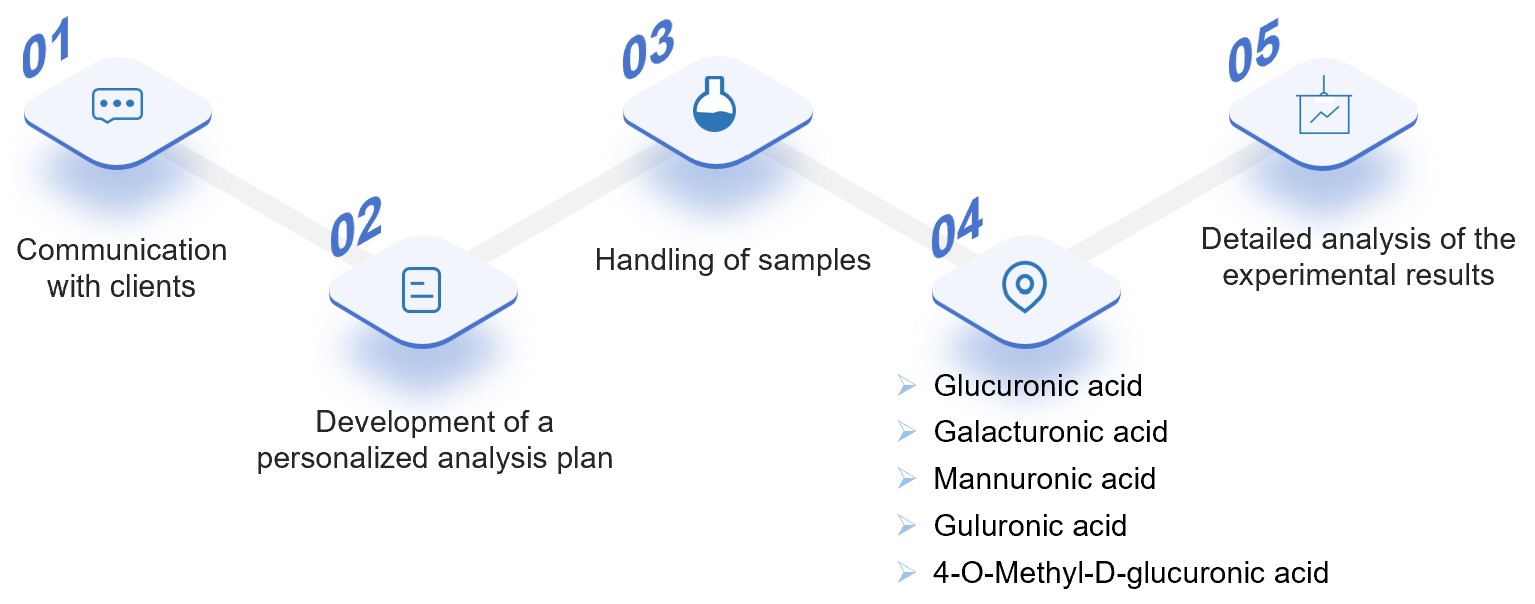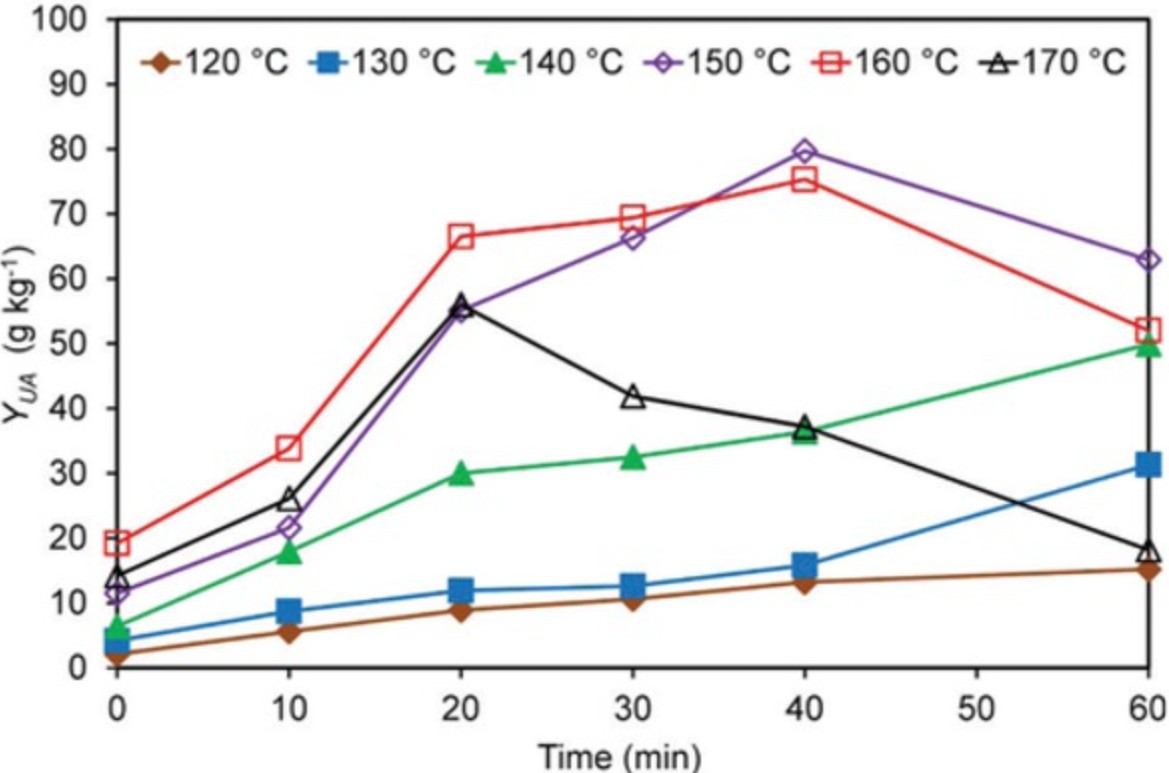Simple Sugars Qualitative and Quantitative Profiling Service
Your Trusted Uronic Acid Analysis Partner
Uronic acids are a common class of simple sugars found in varying proportions in different types of lignocellulose. The uronic acid analysis is critical for unlocking the value of Biomass such as Lignocellulose. Creative Biolabs provides a personalized uronic acid analysis service to evaluate the composition and quality of various lignocelluloses, their value for biomaterials, biotransformation, and other applications for our clients, etc.
Since uronic acids are present in different amounts and proportions in various lignocelluloses, efficient and accurate uronic acid analysis is essential for all types of research. Our experienced researchers have optimized the process of glyoxylate analysis. Using highly efficient ion chromatography, we obtain the uronic acid content of individual lignocellulosic samples, including the following glyoxalate categories:
-
Glucuronic acid: It is found in hemicellulose and is a glucuronic acid formed by the oxidation of glucose.
-
4-O-Methyl-D-glucuronic acid: It is one of the major glucuronic acids in lignocellulose.
-
Galacturonic acid: It is an oxidized form of galactose found in pectin and hemicellulose.
-
Mannuronic acid: It is a glucuronic acid derived from mannose.
-
Guluronic acid: It is a derivative of gulose.
Lignocellulose contains several types of uronic acid. In addition to the types of uronic acid mentioned above, we also test for other types of uronic acid in lignocellulose. Our methods for the analysis of uronic acid apply to a wide range of lignocellulosic, liquid samples. In accordance with the specific needs of our clients, we promptly adjust our analytical solutions and make personalized services to meet the different needs of our clients.
 Fig.1 Uronic acid analysis service.
Fig.1 Uronic acid analysis service.
Advantages of Uronic Acid Analysis Service
-
Accurate results: All samples are analyzed in duplicate for uronic acid analysis to ensure accurate and precise results.
-
Efficient analytical methods: We have optimized the uronic acid analysis process to shorten the project cycle time with good reproducibility.
-
Flexible protocols: We have the flexibility to adapt our uronic acid analysis protocols to the needs of our clients.
With very professional scientists and years of analytical experience, Creative Biolabs provides an efficient uronic acid analysis service to a wide range of scientists and biomass companies. In addition to uronic acid analysis, we also provide high-quality lignocellulosic composition analysis services such as ash content, extractives, starch content, and so on. Welcome to contact us for more detailed information about uronic acid analysis.
Published data
Uronic acid is a valuable organic compound with a wide range of uses in industries such as biomaterials, food, biofuels, and cosmetics. The uronic acid analysis is important in terms of understanding specific components and exploiting the value of biomass. This study showed us how uronic acid analysis could be used to assess the utilization value of waste plant biomass. The researchers examined the effect of different extraction methods on the uronic acid yield of high methyl ester citrus-apple pectin. They used an ion exchange method to separate the uronic acid from the individual reaction mixtures and examined its content. The results showed the best yield of uronic acid at 155°C and 36 min. The utilization of pectin-rich plant waste biomass was found through this study. Also, this study provided data support for the analysis of uronic acid by the ion exchange process.
 Fig.2 Effect of reaction temperature and holding time on the yield of uronic acids.1, 2
Fig.2 Effect of reaction temperature and holding time on the yield of uronic acids.1, 2
FAQs
Q1: Why is it necessary to analyze the uronic acid in lignocellulose when evaluating and studying it?
A1: Uronic acid analysis helps researchers evaluate and study lignocellulosic processes in depth. By analyzing uronic acid, researchers better understand specific components of lignocellulose and their potential as raw materials for various bio-based products. This helps in developing effective bioconversion processes and better utilization of lignocellulosic resources.
Q2: Which polysaccharides contain uronic acid?
A2: Uronic acid can be attached to hemicellulose as a side chain. The concentration of uronic acid varies in different materials. For example, graminaceous plants contain more uronic acid in the early stages of growth. The concentration is higher at the nodes than between the nodes. In addition to this, pectin contains a variety of uronic acids.
Customer Review
Practical and Feasible Analysis
"As a biotech company specializing in alternative energy development, we often needed to test samples for uronic acid. Since working with Creative Biolabs, we no longer had to worry about the accuracy of our uronic acid testing. Their uronic acid analysis service is fantastic. After understanding our specific needs, they gave us a realistic analysis plan and completed the entire analysis project quickly. This helped us to better find alternative sources of energy and optimize our processing methods."
Accelerating Biomass Research
"Creative Biolabs is a very trustworthy partner. Their uronic acid analysis services kept our needs satisfied. Their researchers were also very professional and developed customized plans to meet our actual needs. With their detailed analysis results, we were also in a better position to quickly and accurately assess the quality of lignocellulose and develop effective bioconversion processes."
References
-
Pińkowska, Hanna, et al. "Production of uronic acids by hydrothermolysis of pectin as a model substance for plant biomass waste." Green Processing and Synthesis 8.1 (2019): 683-690.
-
Under Open Access license CC BY 4.0, without modification.
For Research Use Only.
Related Services

 Fig.1 Uronic acid analysis service.
Fig.1 Uronic acid analysis service.
 Fig.2 Effect of reaction temperature and holding time on the yield of uronic acids.1, 2
Fig.2 Effect of reaction temperature and holding time on the yield of uronic acids.1, 2

